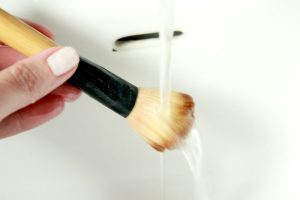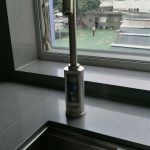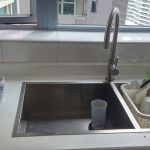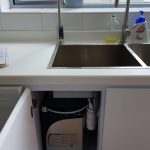 Hygiene practice in the home includes the categories of personal hygiene, food hygiene, environmental or surface hygiene, and home health care. Health and hygiene issues include food borne infections, viral gastroenteritis, common cold virus infections, skin infections and zoonoses with domestic pets, especially young children, elderly and immune compromised person. Home common area environment providing a risk of occurrence of cross contamination. Potential pathogens from sources such as raw foods, persons, and animals can be transferred between inanimate and animate surfaces through either direct or indirect contact. During outbreaks of infection within the home, the transfer between animate and inanimate surfaces may even give rise to cyclic infection. Study show several area in the home is the high risk for cross contamination which, include toilets, kitchen counters, cutting boards, hand and food contact surfaces, kitchen sponges and laundry cloths.
Hygiene practice in the home includes the categories of personal hygiene, food hygiene, environmental or surface hygiene, and home health care. Health and hygiene issues include food borne infections, viral gastroenteritis, common cold virus infections, skin infections and zoonoses with domestic pets, especially young children, elderly and immune compromised person. Home common area environment providing a risk of occurrence of cross contamination. Potential pathogens from sources such as raw foods, persons, and animals can be transferred between inanimate and animate surfaces through either direct or indirect contact. During outbreaks of infection within the home, the transfer between animate and inanimate surfaces may even give rise to cyclic infection. Study show several area in the home is the high risk for cross contamination which, include toilets, kitchen counters, cutting boards, hand and food contact surfaces, kitchen sponges and laundry cloths.
Large number of bacteria organisms and viruses in household toilets is easy to find on surfaces after flushing. Detecting of these organisms on bathroom surfaces indicated that they remain airborne and viable long enough to settle on surfaces and can potentially cause infection either in their airborne state or as a result of cross contamination from inanimate surface.

The potential for cross contamination in the kitchen via counters, cutting boards, hand and food preparation contact surfaces by raw meat, raw foods bacterial pathogens can contaminate and survive on kitchen surfaces and subsequently cross contaminate other foodstuff, such as salad vegetables and cooked meats. Kitchen sponges and rags have been found potential to cause cross contamination to both animate and inanimate surfaces is well established.
The risk for cross contamination via household laundry was clearly demonstrated after an outbreak of staphylococcus aureus skin infections among families sharing laundry facilities. Both viral and bacterial pathogens cross-contamination between different items during laundry process especially general environmental protection trend toward lower wash temperatures, lower volumes of water and less use of sodium hypochlorite.
Is important to keep ourselves and home clean so as to reduce the spread of infections, such as methicillin-resistant Staphylococcus aureus (MRSA) infection. All along, MRSA infection has been affecting hospitallsed patients mostly. However, in recent years, more and more cases have been found in healthy individuals. MRSA infection is transmitted through direct contact with wounds, discharge and soiled areas, usually via hands which may then contaminate other body parts, other persons or items. Maintaining personal and household hygiene can effectively prevent the disease.

 Is important to keep ourselves and home clean so as to reduce the spread of infections, such as methicillin-resistant Staphylococcus aureus (MRSA) infection. MRSA infection is transmitted through direct contact with wounds, discharge and soiled areas. Effective home hygiene practices should include steps to limit the potential transfer of pathogenic microbes from one areas to other more sensitive surfaces such as foods and the hands, particularly when there are higher risk persons present or in the event of a higher-risk situation, such as the occurrence of enteric infection.
Is important to keep ourselves and home clean so as to reduce the spread of infections, such as methicillin-resistant Staphylococcus aureus (MRSA) infection. MRSA infection is transmitted through direct contact with wounds, discharge and soiled areas. Effective home hygiene practices should include steps to limit the potential transfer of pathogenic microbes from one areas to other more sensitive surfaces such as foods and the hands, particularly when there are higher risk persons present or in the event of a higher-risk situation, such as the occurrence of enteric infection.
Ozone has a very strong oxidizing power with a short reaction time, ozone can effect over a wide PH range and rapidly reacts with bacteria, viruses, and protozoans. Ozone has stronger germicidal properties then chlorination and the treatment process did not release any chemicals to the water. Ozone can eliminate a wide variety of inorganic, organic, taste and odor problems. The microbiological agents include bacteria, viruses and protozoans (such as Glardia and Cryptosporidium).
- Cleaning – Use ozonated water for daily disinfection of clothing, dishes, baby’s toys and more
- Oral Hygiene – Brush teeth, rinse mouth and gargle with ozonated water to freshen breath and prevent oral diseases such as gingivitis
- Odor Removal – Oxidize smell in kitchen linen such as wrapping towels and sponges. Oxidize pet odor and smoke damage after rise.
- Food Sterilization – Rinse fruits and vegetables for neutralization of residual pesticides and fertilizer, and to kill surface bacteria and viruses
- Water Treatment – Sterilization, disinfection, removal of impurities and clarification of water through oxidation








